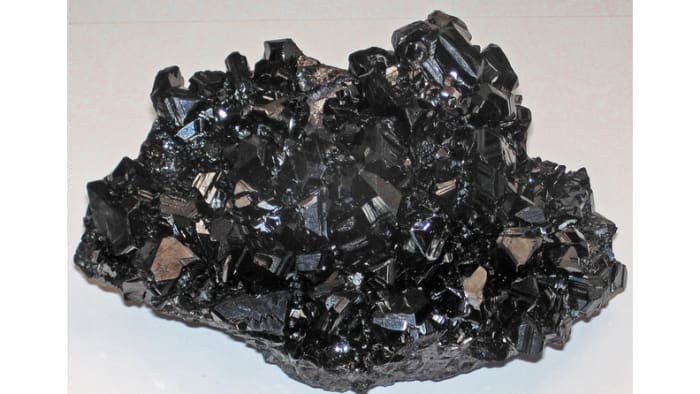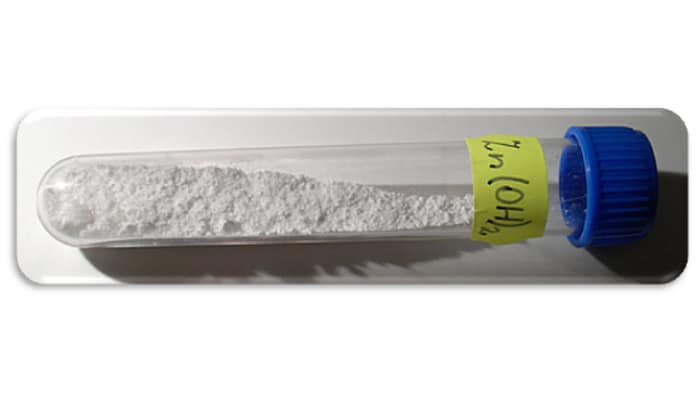Properties of zinc
Reactions with zinc and its compounds

Zinc is an element of the side subgroup of the periodic table (in the 4th period and the 12th group (according to the new classification). It is usually encountered in nature in the form of compounds (the most important natural minerals containing zinc include sphalerite ZnS, smithsonite ZnCO₃, zincite ZnO, calamine 2ZnO·SiO₂·H₂O). Although the oxidation state of zinc in compounds is +2 and it is in the 2nd group of the periodic table, the metal (both in free and bonded form) displays amphoteric properties (i.e. depending on conditions it may display acidic or base properties).
Physical properties of zinc, how zinc is obtained
Metallic zinc is a silvery-gray metal with a melting temperature of around 419.5 °C (787.2 degrees °F). At 100 °C (or 212 °F), the metal is malleable. It is rather brittle at room temperature.
Metallic zinc is obtained from enriched ore (usually sphalerite ZnS is used for these purposes).

Zinc sulfide is baked in ovens, changing from a salt to an oxide:
2ZnS + 3O₂ = 2ZnO + 2SO₂
When baking ends, zinc is reduced from its oxide. This can be carried out by the pyrometallurgical method (the metal is reduced from oxide by coal or coke):
ZnO + C = Zn + CO
at 1200-1300 °C (2192-2372 °F) metallic zinc and carbon monoxide СО
Electrolysis of solutions of zinc salts may also serve as a method for obtaining the metal (this is the hydrometallurgical method for obtaining zinc). After treating zinc oxide with sulfuric acid, electrolysis of zinc sulfate is carried out. The following processes take place on the cathode and anode (carbon electrodes), the following processes take place:
A⁺: 2H₂O - 4e = 4H⁺ + O₂
K⁻: Zn²⁺ + 2e = Zn⁰
2H₂O + 2e = H₂⁰ + 2OH⁻
The summary equation of electrolysis of the solution of zinc sulfate looks as follows (with this reaction, metal of high purity can be obtained):
ZnSO₄ + 2H₂O = Zn + O₂ + H₂ + H₂SO₄
Chemical properties of zinc
As zinc is an element of the side subgroup, we may say that it is inclined to form complexes (it is the central atom of a complex particle). By its properties, it is an amphoteric metal – i.e. it may react both with acids and alkalis. In compounds, zinc always displays an oxidation state of ⁺².
Properties of metallic zinc

For metallic zinc the following reactions are characteristic
- with oxygen (oxides are formed):
2Zn + O₂ = 2ZnO the reaction takes place at a high temperature, at room temperature only a thin oxide film may form on the surface of the metal;
- with sulfur (sulfides are formed):
Zn + S = ZnS (intense heating is required);
- with halogens (halogenides are formed):
Zn + Cl₂ = ZnCl₂;
Zn + Br₂ = ZnBr₂ (reaction is conducted at high temperatures);
- with phosphorus with formation of phosphides:
Zn + 2P = ZnP₂;
3Zn + 2P = Zn₃P₂ (heating to high temperatures is required);
- with ammonia with (nitrides are formed):
3Zn + 2NH₃ = Zn₃N₂ + 3H₂ (reaction takes place at 550-600 °C (or 1022-1112 °F), with molecular nitrogen N₂ zinc does not react);
- with solutions of acids:
Zn + 2HCl = ZnCl₂ + H₂ (with acids zinc reacts like other metals which do not have an amphoteric nature);
- with solutions of alkalis:
Zn + 2NaOH + 2H₂O = Na₂[Zn(OH)4] + H₂
With hydrogen, carbon, silicon, nitrogen and boron zinc does not react directly.
Properties of zinc oxide

Zinc oxide ZnO is a hard white substance which also has amphoteric properties (it reacts with both acids and alkalis):
-
ZnO + 2HCl = ZnCl₂ + H₂O (zinc oxides acts as a base);
-
ZnO + 2NaOH = Na₂ZnO₂ + H₂O (sodium zincate Na₂ZnO₂ forms in the alloying of zinc oxide and sodium hydroxide);
-
ZnO + 2NaOH + H₂O = Na₂[Zn(OH)₄] (sodium tetrahydroxozincate forms when the reaction in the solution is carried out with heating up to 90 °C (194 °F);
-
ZnO + SiO₂ = ZnSiO₃ (in the alloying of zinc oxide with silicon oxides, glassy zinc silicate forms).
Properties of zinc hydroxide

Zinc hydroxide Zn(OH)₂ practically does not dissolve in water. It is a solid substance of a white color, inclined to break down when heated. The chemical properties of zinc hydroxide are the following (the compound is also amphoteric):
-
Zn(OH)₂ = ZnO + H₂O (when heated, zinc hydroxide breaks down into oxide and water);
-
Zn(OH)₂ + H₂SO₄ = ZnSO₄ + 2H₂O;
-
Zn(OH)₂ + CO₂ = ZnCO₃ + H₂O;
-
Zn(OH)₂ + 2NaOH = Na₂ZnO₂ + 2H₂O (sodium zincate Na₂ZnO₂ forms when the reaction is carried out in a flux);
-
Zn(OН)₂ + 2NaOH = Na₂[Zn(OH)₄] (in the solution, sodium tetrahydroxozincate forms);
-
Zn(OH)₂ + 4NH3 = Zn(NH₃)₄₂ (an ammonia complex of zinc forms in an abundance of ammonia).
Click here for making amazing experiments with zinc and learning its properties.
Properties of zinc salts
Zinc salts are prone to hydrolysis, as when dissolves in water, zinc ions reacts with OH⁻ from the water. The water almost does not dissociate into ions, but nevertheless it is inclined to autoprotolysis – the formation of an equal number of cations and anions as a result of the transfer of the proton Н⁺ from one molecule to another:
H₂O + H₂O= H₃O⁺ + OH⁻ – hence hydroxide ions OH⁻ appear, which subsequently react with Zn²⁺. In full hydrolysis, insoluble zinc hydroxide Zn(OH)₂ forms.
ZnCl₂ is zinc chloride (the salt is formed by the weak base Zn(OH)₂ and the strong acid HCl; hydrolysis takes place on the cation, as this salt has the cation of a weak base)

-
ZnCl₂ + H₂O = ZnOHCl + HCl (in the first stage, the main salt forms, zinc hydroxochloride);
-
ZnOHCl + H₂O = Zn(OH)₂ + HCl (in the second stage of hydrolysis, the insoluble weak base Zn(OH)₂ and strong acid HCl form; this is why the reaction of the medium in the solution of zinc chloride is acidic – the acid formed in hydrolysis is stronger than the base obtained).
Otherwise the properties of zinc salts are typical:
-
ZnCl₂ + 2NaOH = Zn(OH)₂ + 2NaCl (zinc hydroxide forms as a white sediment);
-
ZnCl₂ + 2AgNO₃ = Zn(NO₃)₂ + 2AgCl (silver chloride forms as a white cottage-cheese-like sediment);
-
Mg + ZnSO₄ = MgSO4 + Zn (the more reactive metal magnesium forces zinc out of solutions of its salt);
-
ZnCO₃ = ZnO + CO₂ (when heated, the thermic breakdown of zinc carbonate takes place);
-
ZnOHCl + HCl = ZnCl₂ + H₂O
Zinc is used widely in medicine as an antiseptic and anti-inflammatory agent. In industry, alloys and oil paints are manufactured on the basis of zinc. The metal is used in protecting steel from corrosion (this method for preventing metal damage is called zinc plating).